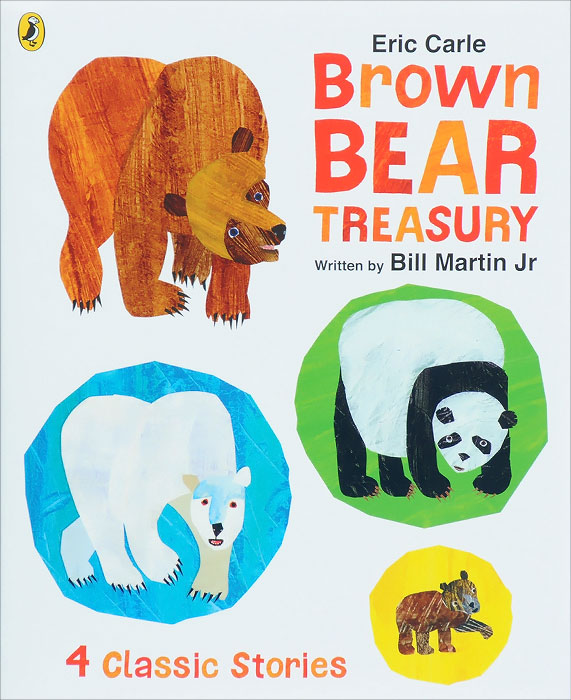Книга: Eric Carle, Bill Martin Jr «Brown Bear Treasury»

|
This very special hardback gift edition includes four bestselling Eric Carle titles: Brown Bear, Brown Bear, What Do You See? Panda Bear, Panda Bear, What Do You See? Polar Bear, Polar Bear, What Do You Hear? and Baby Bear, Baby Bear, What Do You See? These classic picture books feature favourite animals and themes - colours, actions, sounds and babies - all brought to life in Eric Carle's beautiful and distinctive collage artwork. Also by Eric Carle: The Artist Who Painted a Blue Horse; The Very Hungry Caterpillar: The Bad-Tempered Ladybird; Slowly, Slowly, Slowly, Said The Sloth; The Very Bust Spider: Polar Bear, Polar Bear, What Do You Hear? The Very Quiet Cricket; Baby Bear, Baby Bear, What Do You See? Brown Bear, Brown Bear, What Do You See? Издательство: "Puffin" (2015)
ISBN: 978-0-141-35636-5 Купить за 1529 руб на Озоне |
Eric Carle
Eric Carle (born
Early life
Born in
Writing and illustrating career
Educator and author
tyle
Eric Carle’s art is distinctive and instantly recognizable. His art work is created in
The themes of his stories are usually drawn from his extensive knowledge and love of nature— an interest shared by most small children. Carle attempts to make his books not only entertaining, but also to offer his readers the opportunity to learn something about the world around them. When writing, Carle attempts to recognize children's feelings, inquisitiveness and creativity, as well as stimulate their intellectual growth; it is for these reasons (in addition to his unique artwork) that many feel his books have been such a success.
Quotes
“With many of my books I attempt to bridge the gap between the home and school. To me home represents, or should represent; warmth, security, toys, holding hands, being held. School is a strange and new place for a child. Will it be a happy place? There are new people, a teacher, classmates—will they be friendly?
I believe the passage from home to school is the second biggest trauma of childhood; the first is, of course, being born. Indeed, in both cases we leave a place of warmth and protection for one that is unknown. The unknown often brings fear with it. In my books I try to counteract this fear, to replace it with a positive message. I believe that children are naturally creative and eager to learn. I want to show them that learning is really both fascinating and fun.” -"Eric Carle"
Later life
Eric Carle has two adult children, a son and a daughter. He currently divides his time between the
With his wife Barbara, Eric Carle founded The
References
External links
* [http://www.eric-carle.com Eric Carle's web site]
* [http://www.picturebookart.org The Eric Carle Museum of Picture book Art web site]
* [http://www.youtube.com/watch?v=aj3mQkBcJxw Speech by Eric Carle at
Источник: Eric Carle
Bill Martin, Jr.
William Martin, Jr. (1916-
Growing up in Hiawatha Kansas, he graduated from the Kansas State Teacher's College in
In 2000, the Morrill Public in Hiawatha Kansas dedicated the Bill & Bernard Martin Children's Library in honor of Bill and his also-famous brother, Bernard. Bernard Martin is best known as a Midwest wildlife painter and print maker.
Knots on a Counting Rope
*This book, co-authored with
External links
* [http://www.kansasread.org/bmj_bio.htm Bio from the Kansas Reading Association]
Источник: Bill Martin, Jr.
Другие книги схожей тематики:
| Автор | Книга | Описание | Год | Цена | Тип книги |
|---|---|---|---|---|---|
| Eric Carle, Bill Martin Jr | Brown Bear Treasury | This very special hardback gift edition includes four bestselling Eric Carle titles: Brown Bear, Brown Bear, What Do You See? Panda Bear, Panda Bear, What Do You See? Polar Bear, Polar Bear, What Do… — Puffin, Подробнее... | 2015 | 1529 | бумажная книга |
См. также в других словарях:
Brown University — The Brown University Seal Latin: Universitas Brunensis Motto In Deo Speramus (Latin) Motto in English … Wikipedia
United States bear market of 2007–2009 — US Bear market of 2007–2009 The US bear market of 2007–2009 was declared in June 2008 when the Dow Jones Industrial Average (DJIA) had fallen down 20% from its October 11, 2007 high.[1][2] … Wikipedia
France — /frans, frahns/; Fr. /frddahonns/, n. 1. Anatole /ann nann tawl /, (Jacques Anatole Thibault), 1844 1924, French novelist and essayist: Nobel prize 1921. 2. a republic in W Europe. 58,470,421; 212,736 sq. mi. (550,985 sq. km). Cap.: Paris. 3.… … Universalium
Italy — /it l ee/, n. a republic in S Europe, comprising a peninsula S of the Alps, and Sicily, Sardinia, Elba, and other smaller islands: a kingdom 1870 1946. 57,534,088; 116,294 sq. mi. (301,200 sq. km). Cap.: Rome. Italian, Italia. * * * Italy… … Universalium
Austria — Austrian, adj., n. /aw stree euh/, n. a republic in central Europe. 8,054,078; 32,381 sq. mi. (83,865 sq. km). Cap.: Vienna. German, Österreich. * * * Austria Introduction Austria Background: Once the center of power for the large Austro… … Universalium
Northern fur seal — Animalia Northern fur seal Northern fur seal bull, St Paul Island, 1992 Conservation status … Wikipedia
